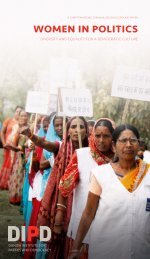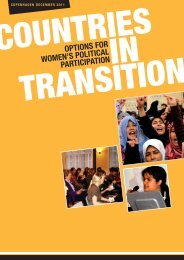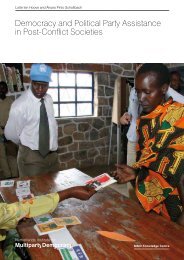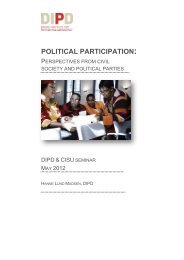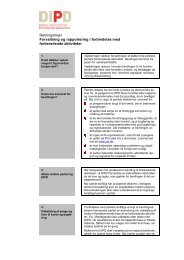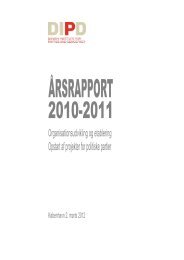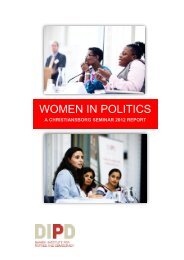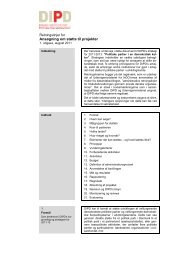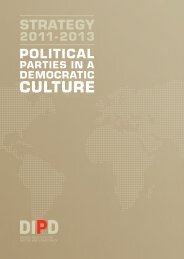Political Parties in Africa: Challenges for Sustained Multiparty
Political Parties in Africa: Challenges for Sustained Multiparty
Political Parties in Africa: Challenges for Sustained Multiparty
You also want an ePaper? Increase the reach of your titles
YUMPU automatically turns print PDFs into web optimized ePapers that Google loves.
International Idea<br />
The UNDP Human Development Report (2006) provides some <strong>in</strong>terest<strong>in</strong>g statistics<br />
which are helpful <strong>in</strong> l<strong>in</strong>k<strong>in</strong>g the general low rank<strong>in</strong>g of <strong>Africa</strong>n countries <strong>in</strong> all<br />
aspects of the Gender-related Human Development Index (GDI) and the Gender<br />
Empowerment Measure (GEM). As a rem<strong>in</strong>der, the GDI is concerned with compar<strong>in</strong>g<br />
female and male <strong>in</strong> respect to life expectancy at birth, adult literacy, comb<strong>in</strong>ed gross<br />
enrolment <strong>for</strong> primary, secondary and tertiary schools, and estimated earned <strong>in</strong>come.<br />
The GEM refers to seats <strong>in</strong> parliament held by women, female, senior officials and<br />
managers, and their earn<strong>in</strong>gs as compared to estimated male earned <strong>in</strong>come. The<br />
Human Development Report (UNDP 2006: 366) shows that, out of 136 countries,<br />
<strong>Africa</strong>n countries occupied 30 out of the lowest 33 positions on the GDI. The only<br />
non-<strong>Africa</strong> countries counted among the lowest 30 are Pakistan, Nepal and Yemen.<br />
In respect to the Gender Empowerment Measure, the Human Development Report<br />
(2006: 369–70) shows that <strong>Africa</strong> aga<strong>in</strong> occupies the bottom 33 rank<strong>in</strong>g positions,<br />
out of 177 countries. (<strong>Africa</strong>, however, <strong>in</strong>cludes some countries with the highest<br />
proportion of women legislators <strong>in</strong> the world. In other words, the representation of<br />
women <strong>in</strong> parliament is not a conclusive measure of women’s empowerment across<br />
other areas, as senior officials and managers, or professional and technical workers,<br />
or their earned <strong>in</strong>come relative to that of men.)<br />
It is there<strong>for</strong>e not difficult to establish the association between the position of women<br />
vis-à-vis the GDI and the GEM and their poor representation <strong>in</strong> high positions <strong>in</strong><br />
<strong>Africa</strong>n political parties. There is no woman president or chairperson of any <strong>Africa</strong>n<br />
political party, although there are a handful of women speakers of parliament and<br />
one woman president (President Ellen Johnson-Sirleaf of Liberia).<br />
Not<strong>in</strong>g that the number of women voters is larger than the number of men voters (see<br />
e.g. López P<strong>in</strong>tor and Gratschew 2002: 95–101), it is evident that across the board<br />
<strong>in</strong>creas<strong>in</strong>g women’s representation <strong>in</strong> politics and public life cannot be achieved by<br />
electoral system re<strong>for</strong>m alone. The <strong>Africa</strong>n experience has shown that a host of other<br />
<strong>in</strong>struments is equally important—constitutional and legal <strong>in</strong>struments as well as<br />
party self-discipl<strong>in</strong><strong>in</strong>g measures.<br />
In the follow<strong>in</strong>g section of this report, we have drawn heavily on International IDEA’s<br />
2004 book entitled The Implementation of Quotas: <strong>Africa</strong>n Experiences, with special<br />
reference to the political representation of women. Three chapters of the book stand<br />
out as exemplary contributions to the debate. These are Aili Mari Tripp on ‘The<br />
Chang<strong>in</strong>g Face of <strong>Africa</strong>’s Legislatures: Women and Quotas’; Colleen Lowe Morna,<br />
‘Beyond Numbers: Quotas <strong>in</strong> Practice’; and Julie Ball<strong>in</strong>gton, ‘Conclusion: Women’s<br />
<strong>Political</strong> Participation and Quotas <strong>in</strong> <strong>Africa</strong>’. Because the reader can consult these<br />
Party Structures and Internal Organization



